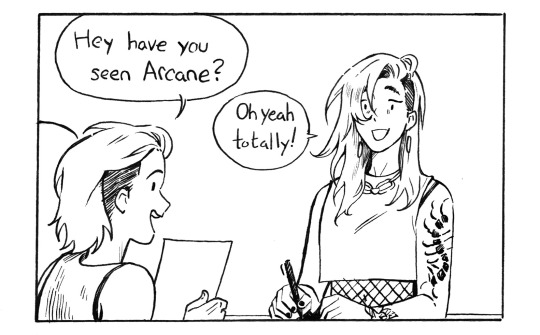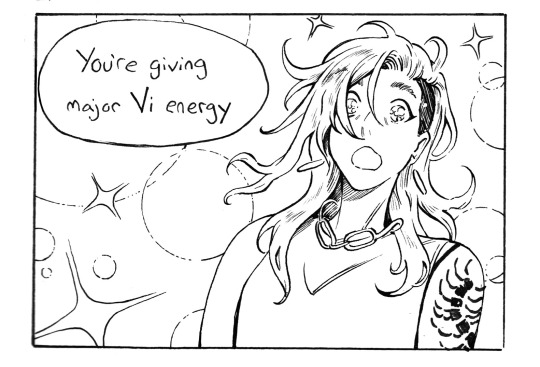Photo

If Tim was a normal person, he would probably mind his own damn business and ignore the noise. Then again, if Tim was a normal person, he’d probably be asleep in his bed at Drake Manor.
this is an illustration for a scene in the first chapter of birds fly in every direction by @batfam-chaos !!
4K notes
·
View notes
Photo






Icons from Batman: Wayne Family Adventures (2021)
5K notes
·
View notes
Text
*releases pack of dads into home depot* go……be free
991K notes
·
View notes
Text

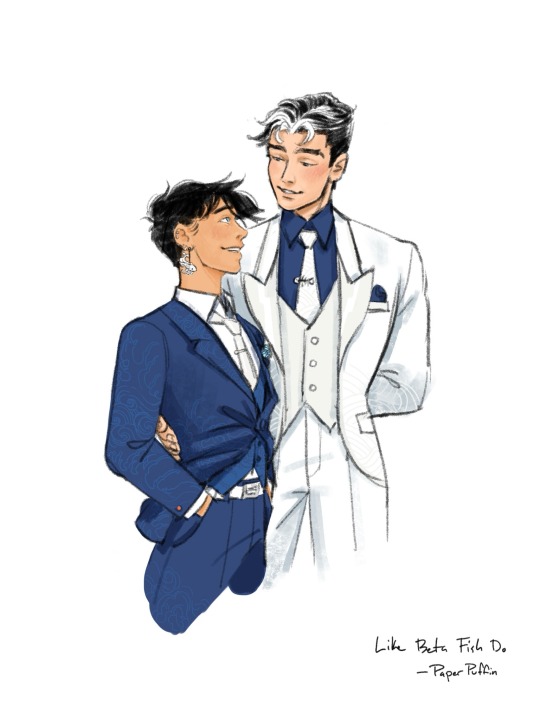

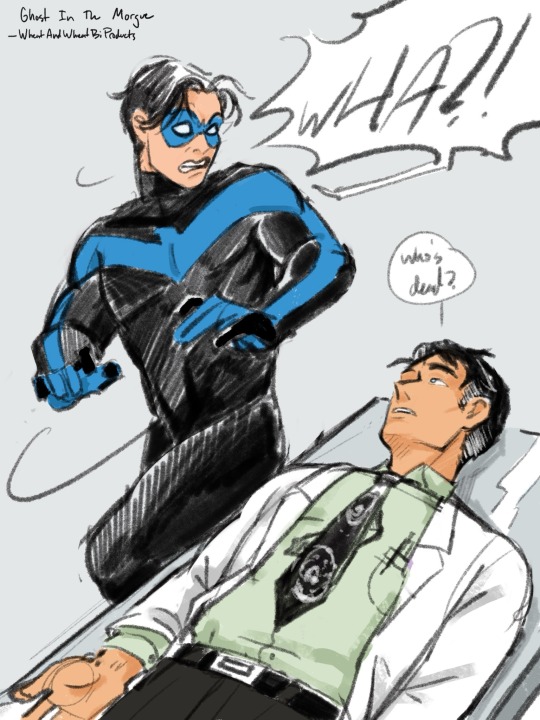
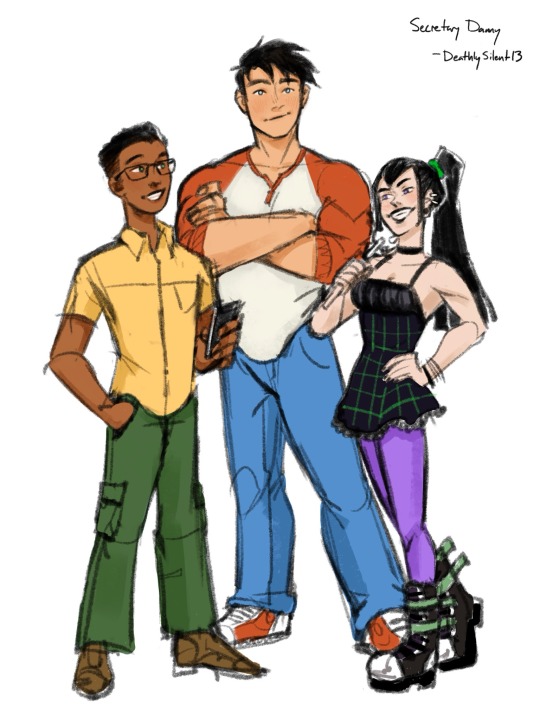

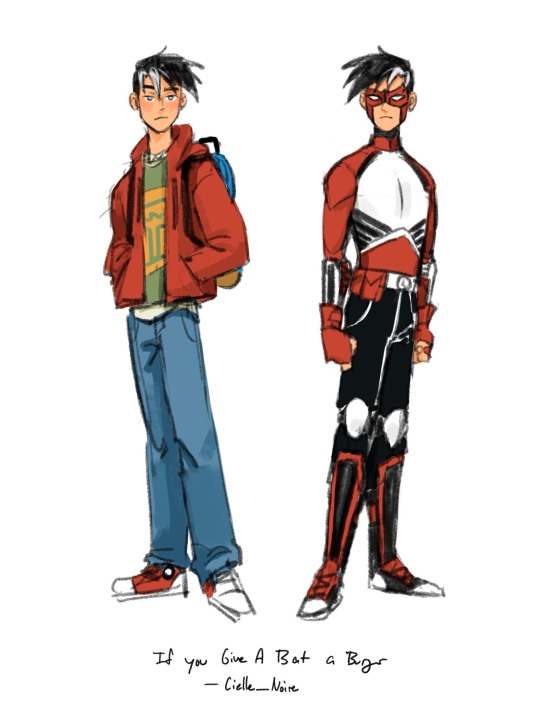
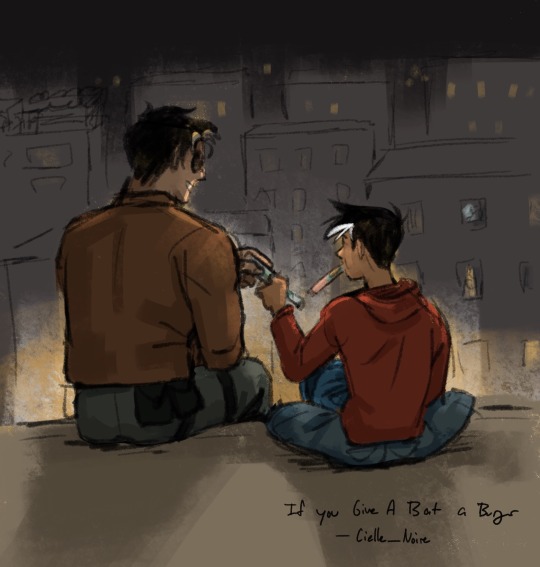
Hello
So I’ve been binging a bunch of DPxDC crossover fics cause they’re hella fun. And I wanted to make some fanart for a handful of the fics I’ve been reading just to show how vastly different Danny gets portrayed. It’s really fun!! I love when ppl make Danny get Jack’s tall ass gene’s, but it’s also funny to see him as a scrawny lil guy. He’s a pretty moldable character
Anywho, it’s just been fun, so here’s some fanart. Thanks to the authors for writing them 🙏
Fics in order of art:
Like Beta Fish Do by @clockwayswrites
Ghost in the Morgue by @the-witchhunter
Secretary Danny by @deathlysilent13
If You Give a Bat a Burger by @noir-renard
If you give any of these a read, just make sure you mind the tags/ratings
6K notes
·
View notes
Text
been stewing on an analytical approach to fiction which I call "is this book afraid of me?" and in order to answer this question you determine how hard the book is trying to make sure you don't come after the writer on twitter
63K notes
·
View notes
Text
To the people in the OTW Tumblr Inbox asking about how the OTW is responding to the American Election.
This is a separate post (and not a response to a specific message) because we all need to see it.
Folks have been asking Support (through the form) as well as the other social media mods, and we have now been given the following to tell you.
We are continuing to closely monitor political developments that may affect AO3 and the OTW as a whole. First, we want to assure you that there are several factors that tend to protect AO3 and its users from legal risks and challenges. These include that we are a non-profit, do not host images, do not use algorithms to promote or advertise content to users, are not aimed at children, and collect very little user data. The results of the 2024 U.S. election are deeply concerning, but the OTW remains committed to providing an inclusive space for fannish expression and will continue to fight for fans' free expression, both in court and through legislative efforts, in the U.S. and worldwide. We have seen that fans are a powerful force for promoting free expression, and we will continue to inform people about opportunities for their voices to be heard. If a bill is likely to be passed in the future that could impact our ability to provide services, our legal team will be prepared to offer updates, guidance, and legal support to our users. Fans are not alone in this fight. Both the American Civil Liberties Union (ACLU) (https://www.aclu.org/news/civil-liberties/the-aclu-is-fighting-back-against-trump ) and the Electronic Frontier Foundation (EFF) (https://www.eff.org/deeplinks/2024/11/2024-us-election-over-eff-ready-whats-next ) made preparations for this outcome and have developed strategies to combat anticipated efforts to curtail online freedoms. We urge our users to support these organizations and others as they fight for your rights and ours.
<3 Mod Remi
6K notes
·
View notes
Photo




word of honor x stardust 2007, part 2: slowburn speedrun
part 1
4K notes
·
View notes
Text

Simmers, I bring you gifts once more. This time the stuff smells like bamboo and green tea on simmering coals.
According to legends, the Onryō is a vengeful spirit. "Resentful, ruthless, and determined to pay back wrongs done to it in life" huh? Sounds like it fits me just right. This set is my revenge. It is what I had hoped and wanted from Snowy Escape that EA did not deliver. While I am not Japanese myself, I have great respect for the people living there and hope the love I put in it shows through. Greetings from central Europe!✌️
For Onryō I focused on functionality and simplicity over grandeur. If you expect this to be an anime set, it is not. It's tagged as "basic" and "modern" design styles, but don't let that stop you from being creative. This set was made with as much love as it was made to show EA that, yes, not everything has to be the same normed re-mesh over and over again.
Download: Merged version Zip Folder version
Look below the cut for more previews and the catalog

This set comes with a lot of interactive furniture and some build objects that are designed to blend and mix with as many other sets and packs as possible. Some highlights are:
Blinds that open and close
Zaisu and chabudai styled chairs and tables
Functional bags that double as dressers
A working irori fire pit
Two butsudan, each a different size

Here is the set mixed together with some furniture from Snowy Escape. Works well together, nah? I'm personally really happy with it and I hope you find it useful.
1K notes
·
View notes
Text
hp houses
The Sorting Hat Chats
“The Basics”
The basic structure of the sortinghatchats system is that you aren’t just sorted into one House, but into two tiers of Houses: Primary and Secondary.
Your Primary House defines WHY you do things.
Your Secondary defines HOW.
To build this system, we’ve drawn on the Sorting Hat’s songs, general HP canon, extracanonical data (ex. interviews with JKR)… and then extrapolated.
People are complex– for joy or for utility, due to social pressure or careless recreation, people often use the reasoning or methods of Houses that aren’t their Primary or Secondary. We call this “modeling” or “performing” a house and we will explain it in greater detail later. These additional layers help us capture some complexities in characters that we couldn’t get using Primary and Secondary alone. People can vary hugely in how they embody their Houses; in this system, Aang, the heroic pacifist protagonist from Avatar the Last Airbender, shares most of his Houses with HP’s Lord Voldemort.
The way you decide which Houses are yours is not necessarily by looking at what you do, but at what would make you proudest and most content if you were strong enough to do it. Your sorting is what you want to be and what you believe you should do, whether or not you actually live up to it. That’s how people like Peter Pettigrew can end up in Gryffindor.
PRIMARIES
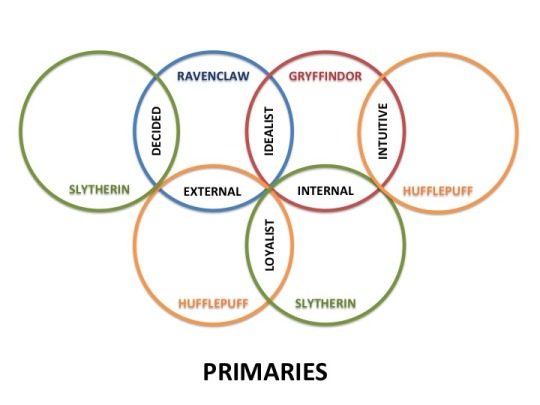
Your Primary is your why. It’s your motivations, your values, and the way you frame the world around you. It’s how and what you prioritize, and what you weigh most heavily when making your decisions. People often also assume that others share those priorities. A common response to our system is “but you must oversort into Gryffindor/Slytherin/Ravenclaw/Hufflepuff–everyone has that type of morality, deep down!”
Gryffindor Primaries trust their moral intuitions and have a need and a drive to live by them. They feel what’s right in their gut, and that matters and guides them. If they don’t listen to and act on that, it feels immoral.
We call Gryffindor morality “felt” but that doesn’t mean they’re all impetuous, emotional hellions. Gryffindors can still be intelligent, deliberate creatures who weigh their decisions and moralities carefully. Reasoning, intellectualizing and debate can be support for a Gryffindor’s felt morality– but those things can never make a fully satisfying morality in themselves. Some things are just wrong, no matter what pretty words you use to explain them.
Ravenclaw Primaries have a constructed system that they test their decisions against before they feel comfortable calling something right. This system might be constructed by them, or it might have been taught to them as children, or it might have been discovered by them some point later in life. But it gives them a way to frame the world and a confidence in their ability to interact with it morally.
Ravenclaws do not lack an intuitive sense of morality or gut feeling about things, but they distrust those instincts and have a need to ignore or to dig down deep and dissect those internal moral impulses. Living within their built moral system is as important to a Ravenclaw as to a Gryffindor; it’s the source of the morality that differs between them–what they trust.
Hufflepuff Primaries value people–all people. They value community, they bond to groups (rather than solely individuals), and they make their decisions off of who is in the most need and who is the most vulnerable and who they can help. They value fairness because every person is a person and feel best when they give everyone that fair chance. Even directly wronged, a Hufflepuff will often give someone a second (or fifth) chance.
This doesn’t mean all Hufflepuffs are inherently tolerant human beings, any more than all Gryffindors are inherently good, moral creatures. Hufflepuffs tend to believe that all people deserve some type of kindness, decency, or consideration from them–but they can define “person” however they want, excluding individuals or even whole groups.
Slytherin Primaries are fiercely loyal to the people they care for most. Slytherin is the place where “you’ll make your real friends”– they prioritize individual loyalties and find their moral core in protecting and caring for the people they are closest to.
Slytherin’s reputation for ambition comes from the visibility of this promotion of the self and their important people– ambition is something you can find in all four Houses; Slytherin’s is just the one that looks most obviously selfish.
Because their morality system of “me and mine first” is fairly narrow in scope, Slytherins often construct a secondary morality system to deal with situations that are not addressed by their loyalty system.
SECONDARIES
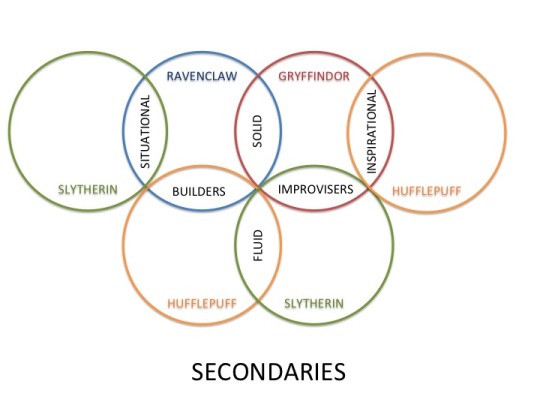
Your Secondary is your how. It’s how you approach the world as a person interacting with it, and how you make your way. It’s how you problem-solve. It’s not necessarily what you’re best at, or even what’s the most useful to you, but about what skills and methods you value as being intrinsic to you. Do you improvise, do you plan? Do you work on something a little bit every day? Do you charge into the fray and tell people exactly what’s on your mind? What do you do? How would you describe the way you meet the world?
Note: the term “Secondary” is not meant to imply that how you do things is any less important than why (the Primary House). It’s simply the way our terminology fell out and we’re too lazy to change it. The importance of motivations v. methods is a personal sliding scale– it’s perfectly valid for a person to identify with their Secondary House over their Primary. (When drawing from canonical sources, we assumed each character likely was in a House that matched to either their Primary or their Secondary. For instance, Harry is in Gryffindor for his heroic Gryffindor Primary, but Ginny Weasley is there for her brash and bold Gryffindor Secondary.)
Gryffindor Secondaries charge. They meet the world head-on and challenge it to do its worst. Gryffindor Secondaries are honest, brash, and bold in pursuit of things they care about. Known for their bravery, it is almost a moral matter to stay true to themselves in any situation that they’re in.
Ravenclaw Secondaries plan. They collect information, they strategize. They have tools. They run hypotheticals and try to plan ahead for things that might come up. They build things (of varying degrees of practicality and actual usefulness) that they can use later– whether that’s an emergency supply pack, a vast knowledge of Renaissance artistic techniques and supplies, or a series of lists and contingency plans. They feel less at home in improvisation and more comfortable planning ahead and taking the time to be prepared.
Hufflepuff Secondaries toil. Their strength comes from their consistency and the integrity of their method. They’re our hard workers. They build habits and systems for themselves and accomplish things by keeping at them. They have a steadiness that can make them the lynchpin (though not usually the leader) of a community. While stereotyped as liking people and being kind (and this version is perhaps a common reality), a Hufflepuff secondary can also easily be a caustic, introverted misanthrope who runs on hard work alone.
Slytherin Secondaries improvise. They are the most adaptive secondary, finding their strength in responding quickly to whatever a situation throws at them. They improvise differently than the Gryffindor Secondary, far more likely to try coming at situations from different angles than to try strong-arming them. They might describe themselves as having different “faces” for different people and different situations, dropping them and being just themselves only when they’re relaxing or feel safe.
But the Journey Continues…
These four basic Primary and Secondary houses are summarized starting places that we use as a basis for further discussion. What are some ways this gets complicated?
A Gryffindor Primary values morality and action, yes– but the moralities of individual Gryffindors vary intensely. They can range from selfless service to dictatorial world domination to confident self-interest.
Hufflepuff Primaries can be cruel, considering only a sparse few to be included in their definition of “people”; or terrifyingly condescending, deciding that they “know best” and are obligated to enforce that best on others.
“Cold, calculating, logical” Ravenclaw Primaries can build systems that are warm and empathetic, or creative and artistic, or fiercely passionate.
Slytherin Primaries, selfish and small, can become loyal to so many people they look like a kindly Hufflepuff; or, so long as their people are safe, a Slytherin might bury themselves in selfless outward moralities, crusading for a cause.
The Secondaries have their own range of possibilities outside the traditional “stereotypes.” A Gryffindor Secondary can be shy, quiet, and reserved– but their stubbornness (however quiet it is) and their devotion to honesty and forthrightness still earns them a place in that sorting.
A Ravenclaw secondary might hate school, learning, and reading, preferring to gather physical and practical knowledge and excelling that way. You can have Ravenclaw secondaries with learning disorders, memory problems, scatterbrained tendencies– the important thing is that they value and find strength in the idea and act of preparation and gathering knowledge, skills, or tools in advance.
A Hufflepuff Secondary can hate people, scorn displays of kindness, and keep their nose tactiturnly to the grindstone– a different Hufflepuff Secondary might be a warm and gregarious friend, offering smiles to strangers. It is consistency, fairness, and hard work that make the House, not their reputation for niceness. Hard work comes in many forms.
Here are a few ways a Slytherin Secondary can appear to others: obviously slimy; so clumsy that their maneuverings just come out cute; sharp as an axe but so much easier to conceal; bluntly honest until backed up against a wall, when they turn into smoke and vanish; adaptable in ways that put everyone in a room at ease; a tireless trickster who delights in playing (or toying) with people. At the end of the day, a Slytherin Secondary defines themselves by their reactivity, creativity, and ability to change– it doesn’t matter what they are changing to, or from, or why.
BURNT PRIMARIES
In addition to the diversity within each Primary, we also have something we call “burning.” A burned House happens when one of the four Primaries loses something intrinsically stabilizing to their system without losing their feeling of how important their original priorities are. This can come from trauma, disillusionment, exhaustion, or just… life. To a “burned” Primary, unburned members of the same House often look childish, naive, or just annoying.
Burned Gryffindor Primaries are Gryffindors who have lost their faith in their internal moral compass. Doing what is right is still just as important, but they don’t know how to know what’s right. To an outside observer, burned Gryffindor Primaries often look more stable and calm than unburned Gryffindors, but this is a deeply unsettling thing to be on the inside of. Many burned Gryffs will find a new system to adopt and live by–but this new system is never as comfortable, satisfying, and natural as their original system.
Corie Halsing from Summers at Castle Auburn, Peggy Carter (who latches onto her somewhat glorified idea of Steve’s “better” Gryffindor Primary) from Agent Carter, and Zoe and Shepherd Book from Firefly are all examples of Burned Gryffindors.
Burned Ravenclaw Primaries have not lost their belief in their morality system– reviewing, discounting, and changing their moral system is often a common and casual Ravenclaw activity. Burned Ravenclaws have lost faith in their ability to build or find a system of truth. Sent into a spiral by realizations of the impossibility of objectivity, or by finding an irresolvable contradiction in their current system, they “fall.” This is the least sustainable of the Burned Primaries, and Burned Ravenclaws don’t tend to stay Burned for long, usually finding a new system.
Some examples of Burned Ravenclaws who stay fallen are Javert from Les Mis (who commits suicide once he Falls) and Bruce Banner from the Avengers (first movie). Jemma from Agents of SHIELD is a Ravenclaw Primary who does find a new system, but spends a good portion of the second season Burned– once a curiosity-driven scientist, the deaths of her friends drive her toward a new system of fear and xenophobic caution.
Burned Hufflepuff Primaries have decided that it’s too hard, impractical, or ultimately futile to care about everyone, and so they have shrunk their circle by changing it from a system that defaults with “I care about you” to a system that says “I cannot care about everyone, so I only care about my people.” It has switched from a basically inclusionary system to a basically exclusionary system.
Burned Puffs look a lot like Slytherin Primaries in this way except that a Burned Puff wants to care about the whole world. They wish they could, but they just can’t. This exclusion of others feels wrong and even evil (burned Houses often consider themselves “bad people”), but the world is an unjust place and you have to try to live in it.
Mal from Firefly and Dean Winchester from Supernatural are both examples of Burned Puff Primaries.
Burned Slytherin Primaries have gone from an inner circle of a few to an inner circle of one (their own self). They have decided that having any people is no longer an option. They’re worried about those people getting hurt or they’re worried about losing those people and being hurt themselves. This character type is often the Ice Queen or portrayed as ruthless, chilly, apathetic, or selfish. With no driving moral forces but their own needs and desires, these people are often cast as villains. Sometimes, Burned Slytherins even burn so far as to kick themselves out of their inner circle, and then don’t even have their own ambitions to guide them.
Jeff Winger from Community, a Burned Slytherin of the first type, struggles to attach to even the friends he makes in the study group. Many of his character plot-lines focus on his fears of abandonment and exclusion, and self-interest is what he’s always able to fall back on.
Can Secondaries Burn?
Secondaries “burn” differently than Primaries. While with a Primary (see above) each House burns in a different way, fully burned Secondaries all look fairly similar. (When they’re still in the process of or partially “burnt,” you can still see hints of the original Secondary to give you a clue).
Secondaries are about methods; a burned Secondary happens when the methods stop mattering. An exhausted or extremely disillusioned person might stop having a preference toward their methods and just do whatever seems the most likely to finish things quickly or effectively. A person with a burned Secondary will use any tactics, from any Secondary, and find joy and comfort in none of them. It might be because their old methods began to seem useless and flawed, or because they somehow lost the strength and confidence to use those old tactics.
When we first meet Bucky Barnes in The Winter Soldier, his brainwashing and intense mission focus has burned his Secondary. He doesn’t care how he gets the job done so long as the job gets done. Helena from Orphan Black, another brainwashed killer, also displays the burned Secondary.
Nico di Angelo, the put-upon son of Hades in the Percy Jackson and the Olympians and Heroes of Olympus novels, burns his Secondary over the course of the books. His Hufflepuff Primary survives grief, betrayal, loneliness, kidnapping, starvation, and mistrust– his Primary still drives him to help those in need. It is his Secondary that takes the damage as Nico rapidly loses any preference to method and just exhaustedly gets the job done. (His interactions with Reyna in the final book suggest Nico, with the help of friends, might be able to recuperate his burned Secondary into something more capable of joy.)
Even though from the outside most Burned Secondaries will look the same to a reader or outside observer, it’s important to note that from the inside, the experience will be fairly different. A Burned Hufflepuff Secondary is going to wish for, want, and grate at different things than a Burned Gryffindor Secondary. Even though both will tend to do “whatever it takes” to survive or achieve their goals, different things are going to bother them more, satisfy them more, or bring them hope.
A note:
Our system is based on the Harry Potter canonical sorting system, especially in the way that it is defined by choice. You can go up to the Hat and sit down and hear it say that you would do well in Slytherin, but if you would rather be in Gryffindor, then you’re a Gryffindor. That’s something we very intentionally keep as a defining point of our system because of how much respect we have for it, both as a facet of life and as a defining motif of Harry Potter. If someone is a Hufflepuff Primary, Ravenclaw Secondary, but identifies as a Slytherin– then, as far as we’re concerned, they’re a Slytherin.
Another Way of Looking at Things
Above we’ve given you a set of brief descriptions of each Primary and Secondary (burned and unburned). Here we’re going to talk about a few ways we group and differentiate between each House. We’ve found looking at the system this way helps when trying to understand where a person or character might fall on it.
Splitting Up the Primaries
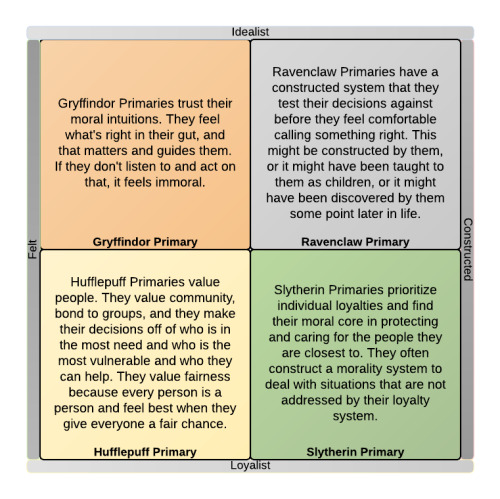
Idealist v. Loyalist
Ravenclaw and Gryffindor Primaries are the Idealists; Hufflepuff and Slytherin Primaries are the Loyalists.
Idealists focus on concepts and truths and what is right and what is good. They are big picture thinkers and have moral drives that closest to what we think of when we think of typical moral drives: this is right because the most people benefit, this is wrong because people get hurt, this is gray so we have to look at the specifics. There is a system of rights and wrongs and in betweens and those things all matter.
Loyalists care about people. Whether it’s a few people or a whole world of people, at the center of their moral system is to do what is best for those people.
Decided v. Intuitive
Hufflepuff and Gryffindor are our Intuitive houses; Ravenclaw and Slytherin are our Decided houses.
Here, the Intuitive houses place an importance on the gut instinct. People are people and that matters, they might say. When asked why, they’re most likely to respond “because of course it does.” The Intuitive houses are united by the moral fire and righteous passion of characters like Mal from Firefly, Steve Rogers, Katara, and Harry Potter.
Intuitive Houses are perfectly capable of questioning, doubting, defying, and changing their beliefs– but they are at their most content and joyous when they are in a situation where they feel able to act on what they think is right without wavering or hesitating.
Decided houses still have gut instincts toward morality, but have constructed systems that they use outside that first intuition.
Ravenclaws are likely to step back and question their gut and, most importantly, place more value on the answer they get from questioning it than on the gut instinct itself. The feeling that drives “of course people matter” is valid, but it’s not enough for a Ravenclaw Primary. Ravenclaws will build their system and test it against examples and logic; or adopt a trusted ally, culture, or religion’s system wholesale and trust that above their own heart. Going with their gut against their reason makes them feel guilty the same way a Gryffindor going against their gut to do the “smart” thing would feel like a sell-out.
A Slytherin’s base morality (roughly: “me and mine first”) is a very Intuitive thing, so why do we call them Decided? That basic morality of their people mattering leaves a lot of gaps in interacting with the world. Different Slytherins deal with those gaps in different ways– sometimes by ignoring them and sometimes by constructing them. Sometimes a Slytherin will adopt a system that looks like one of the other Primaries, living by that other morality unless something threatens one of their people. Because this external system is an important part of how many Slytherins interact with the world, they are included as a “Decided” House.
Also, Slytherin Primaries “choose” their prioritized loved ones in a way that Hufflepuffs don’t. While that Slytherin loyalty is often very passionate, it’s also something that is decided on.
There are some hard corner cases in drawing all these lines (for example, what happens when an idealist’s “right” is a loyalist’s people-first system?) and we will talk more about how to differentiate those in the individual Primary posts.
Internal v. External
Gryffindor Primaries and Slytherin Primaries are the Internal Primaries. Their morality derives from inside themselves– from a Gryffindor’s “gut” or moral compass, or from a Slytherin Primary’s love and valuing of their self and closest people. External influence won’t sway them when they know they’re right. These can be really valuable and powerful primaries when you’re up against gaslighting, corrupt authorities, or external pressures.
Ravenclaw and Hufflepuff are the External Primaries. When what they FEEL contradicts with their external moral inputs (things they’ve learned, things they see in front of them, input from trusted advisers or communities), then they feel obligated to ignore that “little voice inside” for the sake of what’s actually good and true. Being moral isn’t about making the choice that makes you feel good. It’s about making the choice that’s good.
Splitting the Secondaries
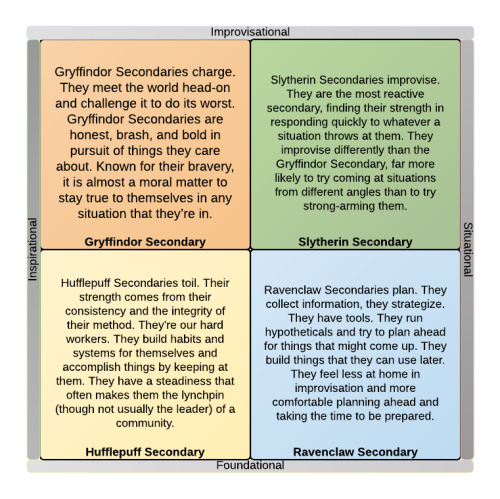
Builders v. Improvisers
In the Secondaries, Hufflepuff and Ravenclaw are the Builders; Slytherin and Gryffindor Secondaries are the Improvisers.
Hufflepuffs and Ravenclaws build. Pushed into hard situations, it is what they already have achieved and brought with them that helps them most. Ravenclaw secondaries make tools to do the things they need, to do the things that delight them, to defend against the things they fear. Hufflepuff Secondaries make themselves into people who can do the things they need, to do the things that delight them, and to defend against the things they fear.
Hufflepuffs toil and work hard at what they want to accomplish and build up a system that is powerful because it is built on sturdy integrity. People trust them to show up, because they always do. They move along at a steady pace: the tortoise to the improviser’s hare. This can look like community building, being the reliable friend who’s always there when you need someone. It can also look like the hard-working student who studies hard and gets all of their work done thoroughly. If a Hufflepuff Secondary cuts a corner then it’s because the corner shouldn’t have been there in the first place.
Ravenclaws data-collect. They build systems and hypotheticals and plan out contingency plans for their plans. They like knowing what they’re getting into before they go into a situation, and while they might still be good at improvising, they don’t prefer it.
You can get Ravenclaw Secondaries who look like Hermione, who studies and can tell you the important (and less important) details from Hogwarts: A History, but you can also have creative Ravenclaw Secondaries who thrive on allowing themselves room for flexibility. You can have painters who, when they studied color, studied all of color until they understood not just which colors work well together, but why they work well together; gardeners for whom looking up how to care for the individual plants in their garden isn’t enough, so they dive head-first into plant biology and soak up all the information they can. When a problem comes up later in painting, in gardening, in life– they can pull something pre-made or pre-learned out of their mental (or physical) pockets and put it to use.
As Improvisers, Slytherin and Gryffindor Secondaries feel best prepared for something when they jump into the middle of it and start reacting to the situation. Going in with a plan can sometimes mess them up.
Katniss Everdeen from The Hunger Games is a great example of a Gryffindor Secondary who needs to improvise: when they gave her scripts to make her inspiring, they fell flat. Her heart wasn’t in them because they felt contrived and disingenuous. When she stepped up lead, when she did inspire, it was spurred on from her gut, taken from the moment, and filled with real feeling. She couldn’t fake it and she couldn’t plan or predict it.
Likewise, a Slytherin Secondary dodges and maneuvers, not charging like a Gryffindor Secondary but changing. They read things moment to moment and meet opportunities head-on. If a Slytherin Secondary goes in with a plan, they might miss an opening that they would have been able to grab ahold of and use to make their point. Remove their ability to be flexible in the moment and they’ll sometimes go so far as to stare blankly at you. Jeff Winger from Community is a good example of this: given time to plan something out he won’t, because he knows that he’s most likely to get what he wants if he just jumps into the action and gives an inspiring (and manipulative) speech at the last moment.
Situational v. Inspirational
Gryffindor and Hufflepuff Secondaries are the Inspirational Secondaries. Their greatest strengths often lie in the effects they have on others. This is not always true nor is it the sole truth of these Houses– but it’s a common and useful tendency between them.
To a degree this is best summed up by the idea of trustworthiness. The forthright presence of a Gryffindor Secondary, sure, secure, and living on their sleeve, tends to inspire in others a desire to follow or believe in them. When they plow forward with their charging improvisational Secondary, Gryffindors often find people following behind them or opening doors in front of them. There can be something so inherently honest about a Gryffindor Secondary that inspires trust.
Gryffindor Secondaries have a tendency to sway even unwilling others to their goals. As leaders by example, or excellent and often unaware speech givers, the certainty with which a Gryffindor Secondary moves can inspire others to believe what they believe. Katniss Everdeen’s unasked for and powerful status as the Mockingjay, a symbol of social change and revolution, is an example of this; so are the unasked-for armies that form around Keladry of Mindelan in the Protector of the Small books. Gryffindor Secondaries are often unaware of the changes they are causing in the hearts and lives around them, though some learn to turn it to their (or the world’s) advantage.
Hufflepuff Secondaries, too, fall into this phenomenon of trustworthiness. There is less of a tendency to follow them to death and mayhem, but more of a tendency to believe them when they speak or ask for favors. Gryffindor Secondaries tend to light people up and make them want to be better– Hufflepuff Secondaries, often background characters even in their own lives, tend to make people feel safe. They’re likely to get secrets, to be allowed places they shouldn’t be, and to thoughtlessly be handed responsibility, powers, and favors. This is a very quiet power and one that can be used for either good or evil.
Even the taciturn misanthrope Hufflepuff Secondary we keep bringing up (they exist!) can have this effect–they are less likely to have powerful loyal communities form around them in quiet support, but they’re likely to be someone who everyone just knows you can rely on. Even unlikeable Hufflepuff Secondaries tend to be relied upon heavily, trusted to get things done– even if their quiet contributions are being overlooked and belittled by people who only understand flashy kinds of power.
Slytherin and Ravenclaw Secondaries are the Situational Secondaries. Situational secondaries tend to excel inside of certain types of situations, rather than succeeding because of an ability to call for aid or inspire those around them. They are at their best in situations that are suited to their skill sets, and are less affected by the larger context the situation takes place in. They would have similar levels of competence in a room filled with their peers as they would in a room filled with strangers.
A Ravenclaw’s core strength of drawing on previous knowledge and a Slytherin’s of adapting to situations both rely on that individual’s skillset. While they can draw on support from the people around them, that’s not where most of their advantage in a situation is going to come from. Support from the people around them is unlikely to be the deciding factor in most everyday situations because that support would not add compatibility to a single person’s adaptation skills, or to a Ravenclaw’s knowledge base.
And while the “inspirational” Hufflepuff Secondary builds things through consistency, creating communities and influential reputations, a Ravenclaw Secondary builds things internally– lists and knowledge and well-vetted strategies. These things only grow more complicated and more likely to prompt disagreement when the thoughts and plans of other people are added into the mix.
Similarly, a Slytherin Secondary has neither the benefits of community that the Hufflepuff Secondary has, nor the ability to inspire that the Gryffindor Secondary has. They are more likely to look like lone wolves, whether because they intentionally present as competent and confident enough to not need help, or because it’s hard for the people around them (especially those who aren’t Slytherin Secondaries themselves) to keep up with their quick shifts and flexible, ever-changing methods.
One of the few places where you do get a Slytherin Secondary who is helped by the people around them is when you have two skilled Slytherin Secondaries who either already know each other or who have compatible methods. That can result in a kind of double-teaming of the situation, with quips layered with information and nudges toward strategy that can leave the people around them both unsure of exactly what’s going on, and swayed toward certain plans of action without being altogether sure why.
Solid v Fluid
Hufflepuff and Slytherin Secondary are our fluid secondaries. They will become whatever is needed to fit the space they are in– to keep the peace, to win their goal, to stay safe they will change who they are and how they act.
Hufflepuff Secondaries have to “feel it” “all the way down” for this transformation to work for them. This ability may come from empathy, altering their mind and point of view to “see through” the eyes of whoever they’re interacting with. It’s genuine– in the moment– but it’s flexible and dependent on context.
Slytherin Secondaries are more likely to just be “code switching,” changing up their mannerism and presentation to fit a new space. They don’t have a need to “mean it” or to feel the emotions they are expressing all the way down to their toes. They act, transform, change.
Gryffindor and Ravenclaw are both more static and more stable. They don’t “transform” the way the fluid secondaries do. With Gryffindor Secondaries, this has to do with their need to be authentically themselves. They lose a lot of power – and a lot of satisfaction and comfort – by not allowing themselves to genuinely react and be.
Ravenclaw Secondaries are strongest in areas they’ve already learned, prepared, studied, or experienced. As such, they may have a hard time being “flexible” in spaces where they don’t already know how to walk the walk and talk the talk.
Models and Performances: More Layers?!
If you’re pulled toward multiple primaries or secondaries, it’s worth looking at whether or not you model some of them. A model is a place you can live. It’s not as intrinsic to you as your Primary or Secondary, but it can still be hugely important.
A model can be useful; it can make you happy; it can make you feel like a good person. It can further the goals of your Primary or help you be more effective in your Secondary. It can be what you want to spend all of your time working toward as long as your Primary isn’t being threatened. You can drop your model (or models! you can have multiple), but that doesn’t mean that you ever want to.
You can model a Primary OR a Secondary (or both!). Just saying “[character] models Slytherin” isn’t useful– though our older posts will often fall into this bad habit. For example: Gale from The Hunger Games models Slytherin Primary– it’s this ability to prioritize of the people he loves (and who Katniss loves) that allows actual Slytherin Primary Katniss to see him as a good friend and ally. However, Gale looks nothing like a Slytherin Secondary, modeled or otherwise. In contrast, Jemma Simmons from Agents of SHIELD is learning to model Slytherin Secondary– her powers of improvisation, deceit, and manipulation are growing in an awesomely terrifying manner as she’s put into harder and more complex situations– but she’s still often baffled by Fitz’s Slytherin Primary, herself having a solid Ravenclaw Primary.
A performance is a toolkit. If a model is a place you can live, then a performance is a way you can act. It doesn’t feel like it’s really you, not deep down, but it can still be important to you. For people who have consistent performances, this is the layer that often interacts most directly with the world around them. It’s the part that people see the most because it’s the part most on the surface. Someone who often finds themselves a host to parties but who doesn’t do that intuitively might develop a Hufflepuff Primary Performance in order to present themselves properly as a caring, empathetic host. A Gryffindor/Gryffindor passionate about science might develop a Ravenclaw Secondary Performance to “seem” more appropriate in that social context.
Models and performances can be taken on for reasons of delight, necessity, or utility. There is no unifying reason that people choose them. Shirley Bennett of Community uses her Hufflepuff Secondary Performance (sweet voiced endearments and smiles) sometimes for fun, sometimes for manipulation, and sometimes as a threat display.
Due to the strict gender roles of their culture, Katara of Avatar is expected to employ a performance of the often feminine-coded “motherly” Hufflepuff Secondary while her brother Sokka has to don the stereotypical “brave leader” performance of a Gryffindor Secondary. Over the course of the series, they dismantle and complicate these roles, learning to embrace the strengths they have rather than the ones they are supposed to have
Lorelei Gilmore of Gilmore Girls, who shares a Slytherin Secondary with her mother, has such an intense dislike of the manipulations and subtleties of her childhood house that she created herself a forthright Gryffindor Secondary model to use during emotional conflicts.
A note:
One person might have just a Primary and Secondary House. Another person might have a Primary, a Secondary, two Primary models, a Secondary model, and a Primary and a Secondary Performance; another just a Primary, their Secondary House having been burned away. Neither of these options are more or less complete than other, and lacking models and performances doesn’t mean that you’re any less complex of a person.
The Quiz:
If you’ve read all this way (or if you didn’t), you might be interested in our Sorting Hat Chats quiz, located here: https://ejadelomax.itch.io/sortinghatchats
The quiz can take anywhere from ten minutes to three hours, depending on how much you argue with it. You can argue with it! Remember, the wizard chooses the House…
Want to learn more? Check out some of our further posts here:
Gryffindor Primary
Ravenclaw Primary
Hufflepuff Primary
Slytherin Primary
Gryffindor Secondary
Ravenclaw Secondary
Hufflepuff Secondary
Slytherin Secondary
Our posts are also all archived on our blog: sortinghatchats.wordpress.com
1K notes
·
View notes
Text
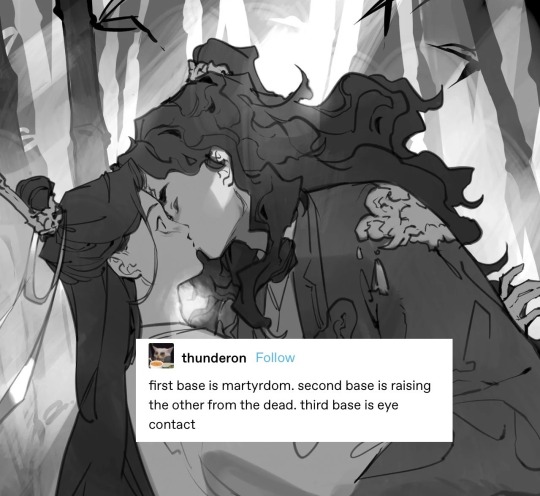
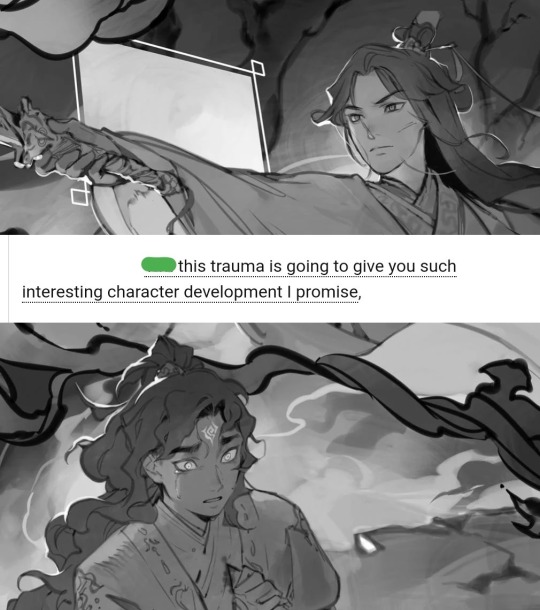

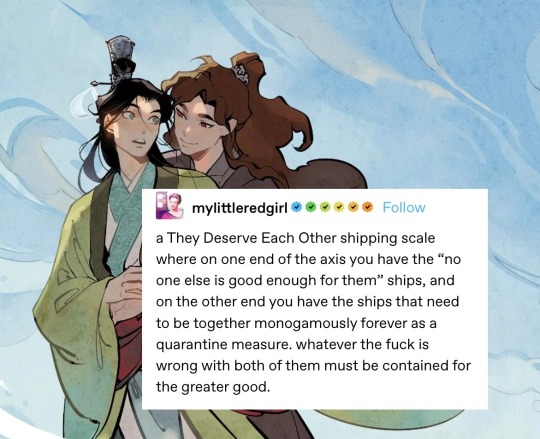



no one is doing it like bingqiu (svsss tpmeme 3/?)
4K notes
·
View notes
Text
Mxtx love interests and their relationships with captivity are fascinating and all, but I’d rather just focus on how funny Hua Cheng’s is in particular.
We have Luo Binghe‘s creepy replica bamboo hut and the tragic horror of watching him succumb to his worst impulses and try destroying the world to trap Shen Qingqiu by his side.
We have Lan Wangji warring internally with himself for years over his smothering need to hide Wei Wuxian from the world and save him from himself.
And then there’s Hua Cheng
Professional Gege Catch and Release Wildlife Expert Hua Cheng.
This man is a gege rehabilitation facilitator who does what he loves and loves what he does.
He tags his gege with a gps tracker so he can study his migration patterns. He humanely traps and relocates his gege whenever he’s strayed into danger.
If you hit a gege with your car, all you need to do is call Hua Cheng and he’ll be there with an animal control slip leash, a GoPro to promote his TikTok campaign promoting awareness of gege welfare and conservation to the masses, and Yin Yu is on the phone preparing the treatment center for a new arrival.
He’s one of those guys who lovingly cares for a feral cat colony in his backyard, providing handmade housing with heating and regular check ups.
He’s insane don’t get me wrong. But his crippling self doubt and unbreakable compulsion to provide merged in such a weird way, it comes off a little more wildlife rescue than I think is intended.
3K notes
·
View notes
Text
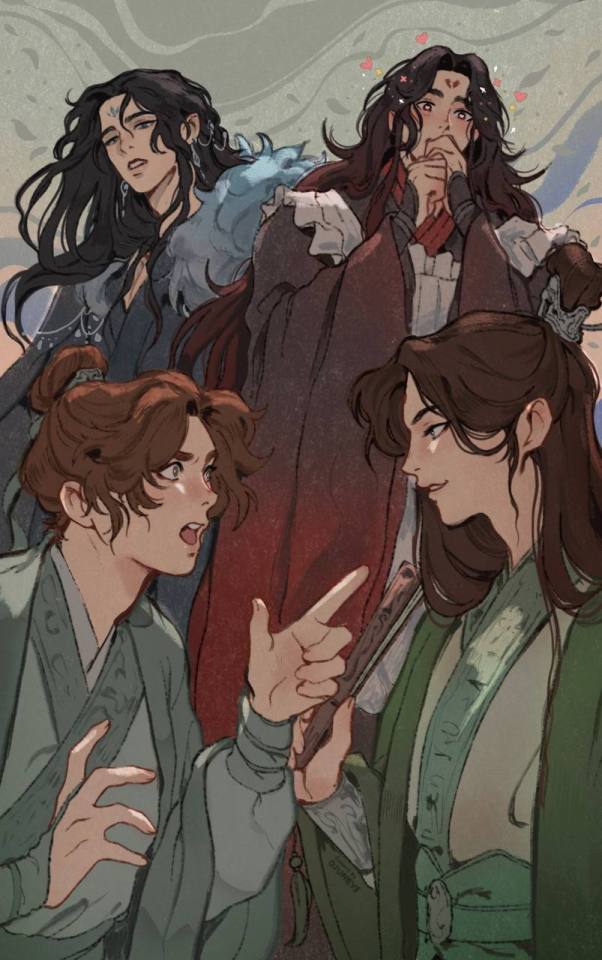

I found the artist on telegram 😭🫶 the way they're looking at their husbands... this style is so so perfect for sv, I can't wait to see the final editions! I don't speak Russian so I'm having kind of a hard time finding out where/when it will be published or if they accept international orders.. if anyone knows anything pls tell me 🙏
5K notes
·
View notes
Text
Chinese new year is almost hereeeee WAAA
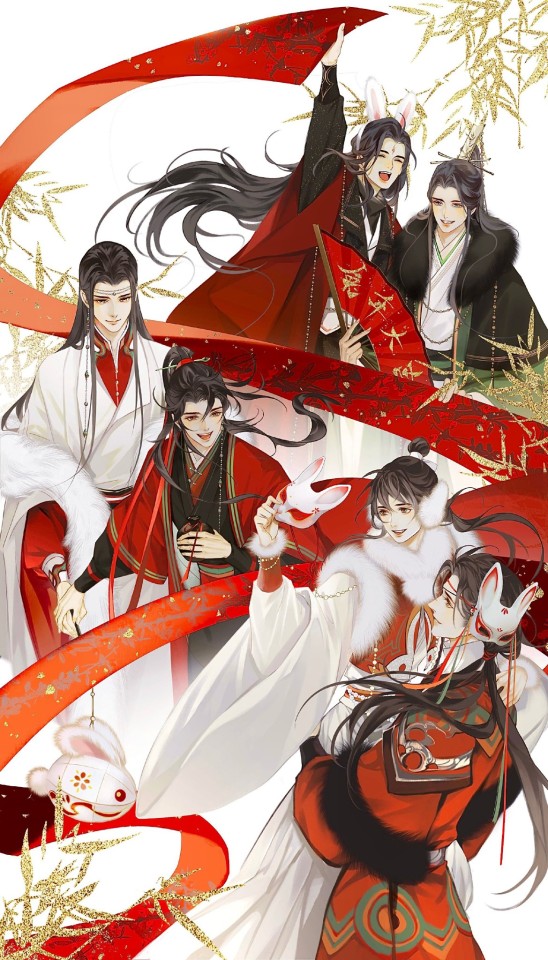
Art by 乌索Yu on Weibo! ✧◝(⁰▿⁰)◜✧
4K notes
·
View notes

